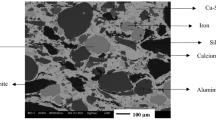The possibility is considered of increasing the electrical conductivity of the electrical contact under dry sliding with current density exceeding 100 A/cm2 by means of application of a molybdenum counterbody. It is shown that sliding of tungsten and a sintered metal composite against molybdenum is characterized by low electrical conductivity and low wear resistance of the contact. It is shown that a change in the contact pressure in the range of 0.02–0.13 MPa and a change in the sliding velocity in the range of 5–10 m/s yields no significant increase in the electrical conductivity and the wear resistance of the contact. The x-ray analysis shows the absence of equilibrium oxides on the sliding molybdenum and tungsten surfaces. Nonequilibrium chemical compounds are also formed during friction. The formation of the transfer layers and their deterioration due to contact adhesion are established. The stress relaxation by the mechanism of low-cycle fatigue in the surface layer is considered as a main reason for fast deterioration of the surface layer and high wear intensity. These data on the structure of the surface layers and the unsatisfactory characteristics of the contact suggest the impossibility of significant improvement of the sliding parameters with current collection against molybdenum and inexpediency of its application as a counterbody under these conditions.
Similar content being viewed by others
References
M. Braunovich, V. V. Konchits, and N. K. Myshkin, Electrical contacts. Fundamentals, Applications and Technology, CRC Press, New York (2007).
V. V. Fadin, M. I. Aleutdinova, A. I. Potekaev, et al., Russ. Phys. J., 60, No. 5, 908–914 (2017).
R. Holm, Electrical Contacts. Theory and Applications, Springer, New York (1979).
I. V. Kragelsky, M. N. Dobychin, and V. S. Kombalov, Friction and Wear Calculation Methods, Pergamon Press, New York (1982).
H. Zhao, Yi. Feng, Z. Zhou, et al., Wear, 444–445, 2031–2056 (2020).
P. Wang, H. Zhang, J. Yin, et al., Wear, 380–381, 59–65 (2017).
A. Hase and H. Mishina, Tribology Int., 127, 372–378 (2018).
A. M. Kovalchenko, P. J. Blau, J. Qu, et al., Wear, 271, 2998–3006 (2011).
M. I. Aleutdinova, V. V. Fadin, Y. Ye. Rubtsov, et al., IOP Conf. Ser.: Mater. Sci. Eng., 156, 012027 (2016); DOI: https://doi.org/10.1088/1757-899X/156/1/012027.
V. V. Fadin, M. I. Aleutdinova, and A. V. Kolubaev, Russ. Phys. J., 57, No. 9, 1278–1282 (2014).
N. Argibay, J. A. Bares, J. H. Keith, et al., Wear, 268, 1230–1236 (2010).
Y. Ohue and K. Matsumoto, Wear, 263, 782–789 (2007).
W. R. Tyfour, J. H. Beynon, and A. Kapoor, Wear, 197, 255–265 (1996).
Y. Zhai, Z. Y. Huang, Sh.-P. Zhu, et al., Int. J. Fatigue, 132, 105345 (2020).
H. Kato, M. Sasase, and N. Suiya, Tribology Int., 43, 925–928 (2010).
W. M. Rainforth, R. Stevens, and J. Nutting, Philos. Magazin A, 66 (4), 621–641 (1992).
M. I. Aleutdinova and V. V. Fadin, AIP Conf. Proc., 2167, 020012 (2019); https://doi.org/https://doi.org/10.1063/1.5131879.
K. Aniołek, M. Kupka, and A. Barylski, Wear, 356–357, 23–29 (2016).
C. H. Hager, Jr. and R. D. Evans, Wear, 338–339, 221–231 (2015).
J. A. R. Wesmann and N. Espallargas, Tribology Int., 94, 360–372 (2016).
Author information
Authors and Affiliations
Corresponding author
Additional information
Translated from Izvestiya Vysshikh Uchebnykh Zavedenii, Fizika, No. 7, pp. 47–51, July, 2020.
Rights and permissions
About this article
Cite this article
Aleutdinova, M.I., Fadin, V.V. Special Features of Deterioration and Structure of the Surface Layers of Molybdenum and Metal Materials Under Dry Sliding with Electric Current. Russ Phys J 63, 1157–1162 (2020). https://doi.org/10.1007/s11182-020-02164-7
Received:
Published:
Issue Date:
DOI: https://doi.org/10.1007/s11182-020-02164-7




